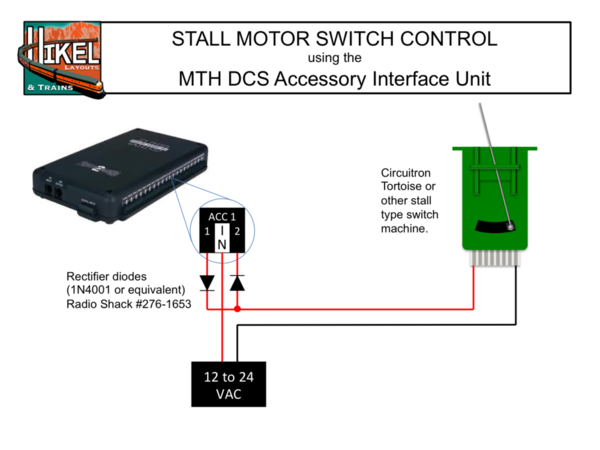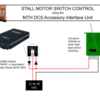Replies sorted oldest to newest
The recommended way is to use a set of latching relays in line between the AIU and the motor. Have a limit switch open the latch when points are in position or just stall the motor, whichever works best.
If you don't want to do that:
The AIU will pass DC but watch the current, the contacts are not rated for a lot.
Also, just press the button a few times until the switch is fully in place.
The AIU contacts are momentary, they only close for a second or less when you hit the switch. A tortoise type motor needs more time to traverse.
You can use 2 Accessory ports instead as they have a ACT option which holds the relay on as long as you press the button. This uses up your accessory ports fast tho.
By the way, I recommend you get Barrys DCS Companion book, pdf or softcover, available thru the MTH website.
It even gives details on how to drive this type motor in several ways from the AIU.
Hi Chris,
If you want to control the switches from the DCS remote's "SW" switch menu you can use the methods Russell described. If you're OK with running your switches from the "ACC" accessory menu you can use this wiring configuration.
Attachments
Dave, thanks for your reply. I would like to use your method to operate the turnouts. I have a dc power supply for them so, Could I just use that instead if the var ac in your diagram and forget the diodes?
I think if you have an AC brick, I would stick with this method that Dave has drawn up.
What is a cobalt motor?
What is a cobalt motor?
Thanks!
No. As enginEErjon said, the diodes are used to rectify the AC voltage into either a + or - DC voltage relative to ground. This also cuts the voltage in half, which is why I showed a 12 to 24 VAC power supply. A 22 VAC power supply, such as a Z-1000 brick, would end up delivering 11 VDC + or - after being rectified through the diodes, which works well with either Cobalt or Tortoise switch machines.
Chris
Meter worked that way because it's pulsing DC, not a steady current.
Vibration for the same reason, the motor is driving and stopping at 60 Cycles per second.
I wouldn't worry about it.
The Cobalt instructions make reference to the diode method and vibration on p.8: http://www.dccconcepts.com/PDF...alt_instructions.pdf
If the vibration or noise is annoying, you could add a 50-cent non-polarized capacitor to smooth out the pulsing half-wave DC. But I suppose it's better to leave well enough alone.






